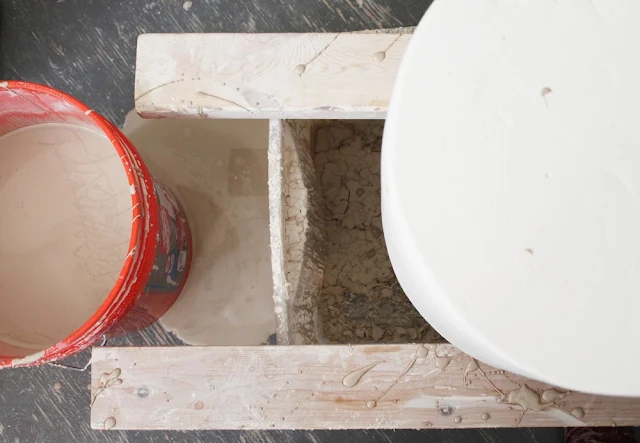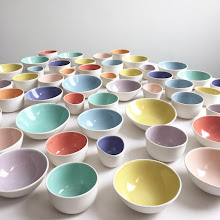The cover had to be spacious enough for the ice bucket to be removed easily. Making a model is a hard process, made more difficult by the fact that my porcelain shrinks about 10% while it goes through all the firings.
For the ice bucket to fit well, the model had to be at least 10% larger than the final product. Quite a design challenge.
I created a model out of plaster, it is giant, and heavy, and took about two months to get right, the first and second try ending up being too small.
The mold for the cover, also out of plaster, is even larger.
It takes 5 gallons of porcelain slip (liquid) to fill the mold all the way to the top.
It is impossible to empty it out by myself, and I end up spilling the slip all over.
When the cover finally comes out of the mold, it has a very rough edge due to being drained upside down.
While the cover is in the ”leather-hard“ stage, I cut out the handles, and clean up the edges with a sponge.
You can see how much the cover shrinks, the knob of the lid is peeking out on top. It is well below the rim in the previous photo. The carrying handles double as a resting place for the ice tongs.
I made four covers, one for me, and three for the client, Lippincott, a graphic design firm in NYC. The covers are glazed blue inside, and ivory on the outside, to match Lippincott’s other gleena dishes, click here to read more about their custom tableware set.
skip to main |
skip to sidebar
archives
-
►
2024
(1)
- March 2024 (1)
-
►
2023
(1)
- August 2023 (1)
-
►
2022
(3)
- November 2022 (3)
-
►
2020
(5)
- September 2020 (1)
- August 2020 (1)
- April 2020 (1)
- March 2020 (1)
- January 2020 (1)
-
►
2019
(3)
- August 2019 (2)
- February 2019 (1)
-
►
2018
(5)
- September 2018 (1)
- August 2018 (1)
- June 2018 (1)
- February 2018 (1)
- January 2018 (1)
-
►
2017
(9)
- December 2017 (1)
- November 2017 (2)
- September 2017 (1)
- August 2017 (1)
- May 2017 (1)
- April 2017 (1)
- February 2017 (1)
- January 2017 (1)
-
►
2016
(18)
- December 2016 (2)
- November 2016 (1)
- October 2016 (2)
- September 2016 (1)
- July 2016 (1)
- May 2016 (2)
- March 2016 (3)
- February 2016 (3)
- January 2016 (3)
-
►
2015
(26)
- December 2015 (2)
- November 2015 (2)
- September 2015 (2)
- August 2015 (3)
- July 2015 (4)
- May 2015 (1)
- April 2015 (2)
- March 2015 (3)
- February 2015 (5)
- January 2015 (2)
-
►
2014
(35)
- November 2014 (1)
- October 2014 (3)
- September 2014 (1)
- July 2014 (2)
- June 2014 (1)
- May 2014 (3)
- April 2014 (6)
- March 2014 (5)
- February 2014 (7)
- January 2014 (6)
-
▼
2013
(69)
- December 2013 (7)
- November 2013 (5)
- October 2013 (2)
- August 2013 (2)
- July 2013 (4)
- June 2013 (3)
- May 2013 (10)
- April 2013 (8)
- March 2013 (10)
- February 2013 (10)
- January 2013 (8)
-
►
2012
(62)
- December 2012 (3)
- November 2012 (4)
- October 2012 (3)
- September 2012 (4)
- August 2012 (1)
- July 2012 (7)
- June 2012 (6)
- May 2012 (2)
- April 2012 (10)
- March 2012 (8)
- February 2012 (10)
- January 2012 (4)
-
►
2011
(71)
- December 2011 (3)
- November 2011 (4)
- October 2011 (7)
- September 2011 (5)
- August 2011 (7)
- July 2011 (3)
- June 2011 (4)
- May 2011 (3)
- April 2011 (9)
- March 2011 (7)
- February 2011 (10)
- January 2011 (9)
-
►
2010
(116)
- December 2010 (4)
- November 2010 (7)
- October 2010 (5)
- September 2010 (8)
- August 2010 (10)
- July 2010 (9)
- June 2010 (16)
- May 2010 (11)
- April 2010 (20)
- March 2010 (8)
- February 2010 (7)
- January 2010 (11)
-
►
2009
(248)
- December 2009 (18)
- November 2009 (16)
- October 2009 (25)
- September 2009 (24)
- August 2009 (29)
- July 2009 (19)
- June 2009 (25)
- May 2009 (28)
- April 2009 (31)
- March 2009 (23)
- February 2009 (1)
- January 2009 (9)
-
►
2008
(51)
- December 2008 (11)
- November 2008 (12)
- October 2008 (10)
- September 2008 (18)
topics
gleena press
- 100 Layer Cake
- alison tauber
- anthology
- anything indie
- apartment therapy
- bearleader chronicle
- best of RI 2008
- better homes & gardens
- blomma finds
- bon appétit
- bonbon oiseau design
- cannelle et vanille
- cooking light
- daily candy
- decor8
- decorology
- design mom
- design*sponge
- etsy wedding
- fine little love
- food & wine
- gourmet worrier
- house beautiful
- housemartin
- inStyle
- lushlee
- martha stewart living
- oh joy!
- oh so beautiful paper
- puddingstone post
- risd ceramics blog
- risd ceramics blog
- slang from chaos
- soule mama
- southern flourish
- style me pretty
- sunday suppers
- tartelette
- the daily meal
- the providence journal
- the storque
- the wall street journal
- thimble+twine
- try handmade
- uppercase
- urban sherp
- veshiwish
- weddingbee
ceramic inspiration
- brickett davda
- christiane perrochon
- cliff lee
- daniel reynolds
- deirdre hawthorne
- diana fayt
- edmund de waal
- elephant ceramics
- galerie besson
- gleena
- heath
- heather knight
- helen felcey
- hyejeong kim
- jan burtz
- karen swyler
- kirstie van noort
- louise boscacci
- mae mougin
- marie hermann
- matin gallery
- middle kingdom porcelain
- mud
- nathalie derouet
- pamela sunday
- royal tichelaar makkum
- rupert spira
- samantha robinson
- stepanka
- taizo
- tania rollond
- the clay studio
- tsé & tsé
- whitney smith












